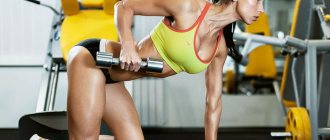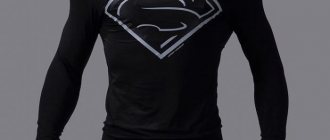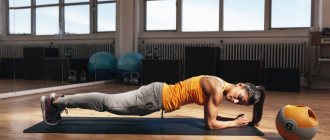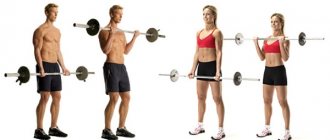If you love interval training to tone muscles and burn calories, then today's selection of programs from the Group HIIT YouTube channel will definitely interest you. Trainers offer high-quality aerobic strength videos with minimal equipment and a very clear and understandable structure of exercises.
Be sure to check out:
- What is HIIT training and its effectiveness?
- Top 50 trainers on YouTube: a selection of the best
Workouts for beginners: description
1. If you are a beginner, we offer you 6 ready-made sets of exercises:
- Mon: Lower body workout (hips and buttocks)
- VT: Interval training for weight loss and body tone - presented below
- CP: Low Impact Cardio Workout
- CT: Upper Body Workout
- PT: Circuit training for problem areas
- SB: Full body stretching
Repeat the program for 6-8 weeks, during which time you will be able to reduce volume, get rid of excess fat, develop endurance, tighten your arms, chest, stomach, thighs, buttocks.
2. Duration of training is 30 minutes, including warm-up for 5 minutes and stretching for 5 minutes. That is, the duration of the main lesson without warm-up and stretching is 20 minutes. This is an ideal time for beginners to work on target muscles without overdoing it.
3. Training is more suitable for girls and women who have a beginner and initial-intermediate level of physical fitness.
See also:
- Top 30 exercises for slender legs
- Top 50 exercises for the buttocks
- Top 30 abdominal exercises
- Program without jumping for girls for 3 days
- Program for men without equipment for 3 days
- Program for men with dumbbells for 3 days
4. For training, you will need a mat and some free space in the room. No other additional equipment is needed.
5. The workouts are suitable for those who want to lose weight, burn body fat and tone their body. This is not a program for muscle growth and increasing volume.
6. How can you make this interval training more challenging to lose weight and tone your body? Use dumbbells or leg weights. You can also increase the number of repetitions (for example, 1.5-2 times) or the time for performing exercises (for example, exercises are performed according to the scheme 30 seconds work / 10 seconds rest, and you can perform 45 seconds work / 15 seconds rest).
7. In the Beginner Interval Workout below, you'll get 3 rounds of exercise + 1 bonus round. The essence of this workout is to alternate exercises for problem areas, which will help you tighten the muscles of the whole body and burn fat due to a high heart rate throughout the entire session. Interval training is fast-paced, so be prepared to work up a good sweat.
- First round: lower body exercise, upper body exercise, abdominal exercise, cardio exercise (repeat 2 rounds)
- Second round: lower body exercise, upper body exercise, abdominal exercise, cardio exercise (repeat 2 rounds)
- Third round: lower body exercise, upper body exercise, abdominal exercise, cardio exercise (repeat 2 rounds)
- Bonus round: 3 static exercises for 30 seconds.
Before the workout, a warm-up warm-up (10 exercises) and muscle stretching on the floor (8 exercises) are also prepared.
8. This program can be performed for a time or number of repetitions of your choice. If you want to do this interval training for weight loss on a count, then the exact number of repetitions is indicated below in the description for each exercise. Please note that if you perform counting exercises without a timer, the total time of the program may differ from the stated one, since the pace of the workout will be individual.
9. If you want to train according to time, then the exercises in both rounds are performed according to the scheme 30 seconds work / 10 seconds rest. Those. You perform a given exercise for 30 seconds, then rest for 10 seconds and prepare for the next exercise, then perform the next exercise for 30 seconds, etc. You can take a longer break between laps, for example, 30 seconds - be guided by your capabilities. To perform using a timer, download a mobile phone application (for example, Tabata Timer) or turn on a ready-made video with a timer:
10. Gradually the body gets used to the load, so in the future it is necessary to move on to more complex and intense programs.
On our website there is also a series of trainings for advanced ones:
- Mon: Intense workout for legs and buttocks
- VT: Advanced Upper Body Workout
- CP: Intense cardio workout at 500 kcal
- CT: Low impact floor workout for problem areas
- PT: Interval training for weight loss and body tone
Whole body workout
Why do you need to warm up? Warm-up exercises will help prepare your body for the load, warm up your muscles, joints and ligaments. Without a warm-up, not only does the risk of injury increase, but the quality of your workout decreases.
In order for the workout to be as effective as possible for weight loss and muscle tone, it is always necessary to warm up and warm up the body before exercise. Warm-up exercises are performed for 30 seconds without rest between exercises. Warm-up should take place at a dynamic pace; your task is to warm up the body.
The warm-up includes the following exercises:
- Walking in place: 40 steps (30 seconds)
- Arm rotation: 15 rotations in each direction (30 seconds)
- Side bends: 15 body tilts in each direction (30 seconds)
- Leg bends: 8 body bends in each direction (30 seconds)
- Body rotation: 5 rotations clockwise and 5 rotations counterclockwise (15 seconds on each side)
- Hip rotation: 5 clockwise and 5 counterclockwise rotations on each leg (15 seconds on each leg)
- Foot rotation: 7 clockwise and 7 counterclockwise rotations on each leg (15 seconds on each leg)
- Half squats: 15 reps (30 seconds)
- Extended arm twists: 15 reps on each side (30 seconds)
- Jackie: 15 reps each side (30 seconds)
1. Walking in place
We begin the warm-up before interval training for weight loss with warm-up walking in place. Feet shoulder-width apart, arms bent at the elbows along the body. Start walking in place, raising your knees up and dynamically moving your arms back and forth. The greater the amplitude during arm movement, the better the muscles warm up.
How much: 20 leg raises on each side (40 steps total) or 30 seconds.
2. Arm Rotation
Stand in place with your feet shoulder-width apart. Start rotating your arms, stretching your shoulder joints and arm muscles. Keep your back straight, squeeze your shoulder blades together, and keep your core stable. Rotations of the arms should be as amplitude as possible. Don't forget to rotate in the opposite direction as well.
How much: 15 rotations clockwise and counterclockwise (30 rotations in total) or 30 seconds.
3. Tilts to the side
We continue to warm up the muscles of the upper body. Place your hands on your waist, feet slightly wider than shoulder-width apart. Raise your right hand up, the left remains at your waist. Start tilting your body to the right. Arch your back, reach for your hand. Then change hands and bend to the other side. Perform alternating side bends at a dynamic pace.
How much: 15 bends in each direction (30 bends in total) or 30 seconds.
4. Tilts towards the feet
Stand straight, spread your legs wide. The arms are spread to the sides (parallel to the floor), the shoulder blades are brought together. Bend towards the floor, turning your body to the side and trying to touch the floor with your fingertips. Return to the starting position and perform a similar tilt in the other direction. This exercise is great for warming up your upper and lower body.
How much: 8 bends in each direction (16 bends in total) or 30 seconds.
5. Rotation of the body
Remain standing with your legs spread wide and your feet flat on the floor. Raise your arms straight above your head and place your palms together. Begin to perform circular movements with your body, tilting your torso towards the floor and maintaining the position of your arms above your head. Don't round your back, keep your shoulders away from your ears.
How much: 5 clockwise rotations and 5 counterclockwise rotations or 15 seconds on each side.
6. Hip Rotation
Stand up straight, put your hands on your waist, look forward. Bend your knee, lift the thigh of your right leg and begin to rotate your leg in circles at the hip joint. Remember to do the exercise clockwise and counterclockwise, as well as with your right and left leg.
How much: 5 clockwise and 5 counterclockwise rotations on each leg or 15 seconds on each leg.
7. Rotation of feet
Now let's do another joint exercise to warm up the ankle, which is easily injured during training. Raise your leg bent at the knee until your thigh is almost parallel to the floor. Rotate your foot in a circle, stretching the ankle joint. The leg remains motionless, only the foot rotates.
How much: 7 clockwise rotations and 7 counterclockwise rotations on each side or 15 seconds on each leg.
8. Half squats
Stand straight, arms free along your body, feet slightly wider than shoulder-width apart, toes turned slightly outward. Lower your pelvis down to a half-squat position, bring your arms together. The knees do not go beyond the toes, the body leans slightly forward. This simple warm-up exercise will perfectly prepare you for the full squats that will be part of your main weight loss workout.
How much: 15 half squats or 30 seconds.
9. Body Rotations with Arm Extended
Now let's do a couple of cardio exercises to warm up the body. Spread your legs wider, hands on your waist. Begin to extend your arm up and to the side, while simultaneously turning your body to the side. Feel how this dynamic exercise not only warms up your body, but also stretches the muscles of your chest, arms, shoulders and back, as well as your buttocks and legs.
How much: 15 reps on each side (30 reps total) or 30 seconds.
10. Raising arms and legs
And we finish the warm-up before interval training for weight loss with a simple cardio exercise. Stand straight, legs together, arms at your sides. Begin to raise both arms up above your head and at the same time walk one leg forward, touching your heel to the floor. The other leg bends slightly at the knee. Feel your pulse rise and your body warm up.
How much: 15 repetitions on each leg (30 arm raises in total) or 30 seconds.
Spider-Man Push-Up
The muscles of the chest, arms and midsection are worked.
- Take the starting position for push-ups. Arms are straightened, abdominals are tense.
- As you release your body, bend your right leg and rotate your right knee so that it touches the outer surface of your right elbow. Do not pull your foot in and try not to turn your body.
- As you push up to the starting position, return your right leg to the starting position and repeat the exercise, touching your left knee to your left elbow. This is one repetition.
Interval training for weight loss: round 1
The first round of interval training for weight loss and body tone lasts 5-6 minutes. This round includes 4 exercises that are repeated in two circles: one exercise for the hips and buttocks, one exercise for the muscles of the arms, shoulders, chest and back, one exercise for the abdomen and one cardio exercise for additional calorie burning.
Exercises are performed according to the scheme 30 seconds work / 10 seconds rest. Can be performed without a timer, counting the number of repetitions.
The first round includes the following exercises:
- Side Squat: 10 reps on each side (30 seconds)
- Knee push-ups + arm raises: 7 reps (30 seconds)
- Knee to belly pull-up on the floor: 15 reps on each side (30 seconds)
- Knee to chest pull-up: 30 reps (30 seconds)
We repeat the exercises in two circles. You can take an additional 30 seconds of rest between circuits. The fourth exercise in the first circle is performed on the right side, in the second circle on the left side.
1. Side Squat
Why: Side squats are one of the best glute exercises that will help you tighten and firm your butt. This exercise also involves the quadriceps, hamstrings (back surface), and adductor muscles of the legs.
How to do it: Stand straight, feet together, palms folded near your chest. Take a wide step to the side with your right foot and squat down. In a squat, your thighs are parallel to the floor, your body is slightly tilted forward, and your knees do not go ahead of your toes. Pull your buttocks back, do not round your lower back. Hold the squat for a second, then straighten up and bring your right leg back. Repeat the same on the left side.
Lighter version: Do not squat deeply, do half squats as in the warm-up part.
How long to do: 10 reps on each side (20 squats total) or 30 seconds.
2. Knee push-ups + arm raises
Why: Push-ups are one of the best exercises for the upper body without additional equipment. During push-ups, the muscles of the chest, triceps, shoulders, abdomen, and upper back are used. By raising our arms up, we will additionally work the triceps - the back surface of the arms, which often sag without power load.
How to do it: Get into a hand plank position and lower to your knees. The feet can be raised up or placed on the floor. Palms are straight, positioned slightly wider than shoulders, elbows pointing back. Do not lift your pelvis up, tense your stomach and buttocks. This is the starting position. Bend your elbows and lower your body parallel to the floor. The chest almost touches the floor, the elbows look back (not to the sides!), the back is straight. Hold for a second, then push your hands off the floor and return to the starting position. From the starting position, alternately lift your arms up along your body so that your elbows are slightly higher than your body.
Lighter version: Do not perform deep push-ups; at first, lower yourself down to at least half the full amplitude. As your strength increases, try to go deeper.
How long to do: 7 repetitions (one repetition includes push-ups + right arm raise + left arm raise) or 30 seconds.
How to learn to do push-ups from scratch
3. Pulling your knees to your stomach on the floor
Why: This easy-to-use floor exercise will help you strengthen your rectus abdominis without putting too much strain on your lower back. In addition, this exercise additionally engages the muscles of the buttocks and quadriceps.
How to do it: Lie on the floor, lower back completely pressed to the floor, stomach tense. Hold your hands in front of you near your chest. Legs are extended, feet are off the floor. Bend one leg at the knee and pull it towards your chest, touching your knee to your hands. Then straighten it and pull the other leg towards your chest. At a dynamic pace, alternately pull your knees to your chest, while keeping your straightened leg on the floor throughout the entire exercise.
Lighter version: You can touch the floor with your straightened leg if it is still difficult for you to keep them constantly suspended.
How long to do: 15 reps on each side (30 reps total) or 30 seconds.
4. Pulling the knee to the chest
Why: Not only is this a great low-impact cardio exercise, but it's also a great exercise for toning your abs and glutes. You will raise your heart rate and feel a pleasant burning sensation in the target muscles.
How to perform: For the starting position, spread your legs wider than your shoulders, lean on your right leg, and your left leg touches the toe of the floor. Your arms are raised above your head, palms placed one on top of the other. The body is slightly turned to the right. As you exhale, pull your left leg bent at the knee towards your chest and at the same time lower your arms down, turning your body. As you inhale, return to the starting position. In this exercise, it is very important to rotate the body, using the obliques, and also maintain a high tempo to burn calories.
Lighter version: You don’t have to raise your arms up and down, but keep them in the same position at chest level.
How long to do: 30 repetitions or 30 seconds. In the second round, perform this exercise on the other side.
Rest 30 seconds before the second round.
Weight Loss Workout: Round 2
The second round of interval training for weight loss and body tone lasts 5-6 minutes. This round also includes 4 exercises that are repeated in two circles: one exercise for the hips and buttocks, one exercise for the muscles of the arms, shoulders, chest and back, one exercise for the abdomen and one cardio exercise.
Exercises are performed according to the scheme 30 seconds work / 10 seconds rest. Can be performed without a timer, counting the number of repetitions.
The first round includes the following exercises:
- Reverse lunges: 10 reps on each side (30 seconds)
- Hyperextension + forward extension: 7 reps (30 seconds)
- Pulse Raise: 10 reps (30 seconds)
- Plank to squat: 8 reps (30 seconds)
We repeat the exercises in two circles. You can take an additional 30 seconds of rest between circuits. The fourth exercise in the first circle is performed on the right side, in the second circle on the left side.
1. Reverse lunges
Why: Reverse lunges are great because, first, they put less stress on the knees than classic lunges. And secondly, they perfectly pump the muscles of the buttocks and back of the thigh, which is usually very important for girls.
How to do it: Stand straight, legs slightly apart, hands on your waist. Tighten your stomach and buttocks, straighten your back, bring your shoulder blades together, and look forward. This is the starting position. Then take a long step back with your left foot. Bend your right knee and lower your left knee toward the floor so that both legs form a right angle between your shin and thigh. The knee of the back leg does not touch the floor. Then push up and return to the starting position. Make sure you keep your torso upright throughout the exercise and do not lean your back forward.
Easy option: Hold onto a wall or chair to maintain balance. You can perform lunges in the first circle on one leg, and in the second circle on the other leg. This will make it easier for you to keep your balance. A very lightweight option: take your legs back one at a time, without bending your back leg at the knee.
How long to do: 10 reps on each side (20 reps total) or 30 seconds.
All about LUNCHES + options
2. Hyperextension + forward extension
Why: Hyperextension on the floor (or superman) is an excellent exercise for strengthening the muscles of the back and lower back, it improves posture and strengthens the muscles of the back and core. In addition, this exercise is a prevention of lower back pain. There are many different modifications of this exercise, we will perform a simple version with an emphasis on the muscles of the arms and upper back.
How to do it: Lie on your stomach so that your whole body is on the floor, your head is raised above the floor. The arms are bent at the elbow and placed along the body at chest level. Lift your upper body up, lifting your chest off the floor, keeping your feet on the ground. Hold this position for a second and then, keeping your body elevated, extend your parallel arms forward, palms facing each other. Stretch your arms forward three times without lowering your body, and only then return to the starting position. This is one repetition.
Lightweight version: Stretch forward alternately one arm and the other, lift your body to a small height.
How long to perform: 7 repetitions (one repetition includes raising the body up + stretching the arms three times) or 30 seconds.
3. Raising the body with pulsation
Why: This abdominal exercise is technically simpler than classic crunches due to the fact that you help lift the body with your arms and do not put strain on your neck. But we will complicate this exercise with pulsating movements.
How to do it: Lie on your back, your lower back is completely pressed to the floor, there is no gap between the floor and your back. Arms extended forward, stomach tucked. Lift your upper body up without lifting your lower back from the floor and stretching forward with your arms. In the maximum position, hold and perform three pulsating lifts. Do not make sudden movements; this exercise should be performed with full concentration on the abdominal muscles.
Lighter version: Perform body lifts without pulsation.
How long to do: 20 reps on each side or 30 seconds.
4. From plank to squat
Why: This is not only an ideal cardio exercise that will quickly get your heart rate up by constantly changing positions, but also an excellent exercise for the thighs, buttocks and abdomen. Do this exercise if you want to burn fat and get rid of problem areas.
How to do it: Stand in a handstand position (hand plank). Pull your leg forward so that your left foot is next to your left palm, then pull your right foot towards your right palm. Straighten your back, lift your arms off the floor, extend them and take a squat position. Then return to the plank position, stepping back first with your right leg, then with your left. In the second round, change the order of the legs.
Lighter version: Move your legs into a plank position without going into a squat and without lifting your hands from the floor.
How long to do: 8 repetitions or 30 seconds. In the second round, perform on the other side.
Rest 30 seconds before the third round.
Interval training for weight loss: round 3
The third round of interval training for weight loss and body tone also lasts 5-6 minutes. This round includes 4 exercises that are repeated in two circles: one exercise for the hips and buttocks, one exercise for the muscles of the arms, shoulders, chest and back, one exercise for the abdomen and one cardio exercise.
Exercises are performed according to the scheme 30 seconds work / 10 seconds rest. Can be performed without a timer, counting the number of repetitions.
The third round includes the following exercises:
- Sumo squat + pulse: 10 reps (30 seconds)
- Raised Arm Pulsation: 40 reps (30 seconds)
- Oblique crunches: 20 reps (30 seconds)
- Alternating forward kicks: 15 reps on each leg (30 seconds)
We repeat the exercises in two circles. You can take an additional 30 seconds of rest between circuits. The third exercise in the first circle is performed on the right side, in the second circle on the left side.
1. Sumo squat + pulse
Why: Sumo squats are considered the most effective exercise for the gluteal muscles and inner thigh muscles. Let's complicate this exercise a little with pulsating movements.
How to do it: Spread your legs wide, knees and toes pointing outward, arms clasped together near your chest, back straight, stomach tucked, buttocks tight. Squat until your thighs are parallel to the floor, bending your knees and lowering your pelvis down. Do not let your knees go ahead of your toes, do not lift your heels off the floor, and do not move your body forward. The knees point in the same direction as the toes. Hold in the lower position and perform three pulsating movements up and down. Then return to the starting position.
Lighter version: Perform a classic sumo squat without pulsation.
How long to perform: 10 repetitions on each side (squat + 3 pulses is one repetition) or 30 seconds.
2. Pulsation of arms apart
Why: This seemingly simple exercise perfectly works the shoulder muscles without complicated positions or additional equipment.
How to do it: Stand straight, feet shoulder-width apart, arms out to the sides and parallel to the floor. Start lifting your arms up and down in a small amplitude, as if pulsating them. Feel the tension in your shoulder muscles. There is no need to wave your arms too much, your arms move within 20-30 centimeters, the shoulder muscles are in constant tension.
Lighter version: Reduce the number of repetitions to 20-30.
How long to do: 40 up-and-down pulsating movements or 30 seconds.
3. Oblique crunches
Why: If in previous abdominal exercises the emphasis was on the rectus muscle, then in this round we will focus on the oblique muscles. In addition, abdominal exercises help strengthen the deep core muscles that support the spine.
How to do it: Lie on your back, bend your knees, tighten your stomach. Cross your arms behind your head. Again, we control the position of the lower back - it should be completely pressed to the floor. As you exhale, twist your body and at the same time lift your leg so that the elbow of your left hand touches your right knee. The lower back remains on the floor. Try not just to connect your elbow to your knee, but to stretch your shoulder up. Your goal is to contract your abs as you perform the movement, not just move your elbows. Pause for a second in the upper position and return to the starting position.
Lighter version: Do not lift your leg, the foot remains on the floor, only the upper body moves.
How long to do: 20 repetitions or 30 seconds. In the second round, perform this exercise on the other leg.
4. Alternating forward kicks
Why: This is an excellent low-impact cardio exercise that quickly raises your heart rate without causing any negative impact on your joints. In addition, you will additionally work the abdominal muscles, gluteal muscles, muscles of the front and back of the thigh.
How to do it: Stand straight, feet shoulder-width apart, arms folded in front of your chest, knees slightly bent. Start lifting your legs forward alternately, as if you want to hit the wall in front. The movement begins with raising the knee to the chest and continues with a sharp straightening of the leg. Stretch forward with your heel, not your toes. This is a cardio exercise, so do it at a fast pace, suddenly changing one leg to the other.
Easy version: Slow down the pace and reduce the height to which your legs rise.
How long to perform: 15 repetitions on each side (30 strokes total) or 30 seconds.
Rest 30 seconds before the bonus round.
Fat burning workout complex for home
A set of exercises for weight loss is also available to perform at home. It is not necessary to use special equipment; your own weight will be enough. Training should last at least 45 - 50 minutes. Fat burning will begin only twenty minutes after the start of the workout, so it is not advisable to train for only 15 minutes. An important condition for losing weight is the pulse zone. A zone of 120–160 beats per minute is considered comfortable for the cardiovascular system and effective for fat burning.
Superset for all muscle groups
The superset is performed without stopping, with a smooth transition from one exercise to another. The number of laps performed depends on what kind of load you want to get. It is advisable to repeat this complex for at least five circles. After performing, do a light stretch of all muscles.
Jump Squats
This type of squat involves all the muscles of the thighs and buttocks, while jumping in place is added, which increases the heart rate for fat burning. It is not advisable to do exercises every day. Unprepared athletes need to rebuild their muscles. This may take 4 - 5 days.
- Starting position: feet shoulder-width apart, toes slightly apart;
- Inhale: lower the pelvis, thigh parallel to the floor, as if sitting on a chair;
- Exhale: jump from the bottom point, lifting your socks off the floor;
- We repeat the squat while inhaling. We perform 20 - 30 times.
Burpee
This type of exercise is very effective for losing body weight, because it is performed at the fastest possible pace and involves absolutely all muscle groups. Depending on your level of training, you can perform it from 20 to 40 times.
- From a standing position, while inhaling, we squat down, placing our palms on the floor;
- Pushing off with our feet, with an exhalation we jump into the plank on straight arms;
- Inhale: jump back to the palms;
- Jump up while exhaling and return to the starting position.
Pushups
This exercise trains the upper shoulder girdle well. You can perform such exercises after 2-3 days, as small muscles recover quickly. Push-ups form correct posture; the main thing is to keep the abs tense, preventing the lower back from sagging. Perform 10 - 15 repetitions. Consider the option with wide palms.
- From a plank position, palms wider than shoulders, feet hip-width apart;
- Inhale: lower the chest to the level of the elbows. Elbows point to the sides;
- Exhale: push up and return to the starting position.
Interval Training for Weight Loss: Bonus Round
In the bonus round you will find 3 static exercises. In static exercises, you will stay in one position for half a minute, thereby engaging not only the core muscles, but also the deep stabilizing muscles. The bonus round can be excluded from the workout if you feel too much stress at first.
Top 30 static exercises
Exercises are performed according to the scheme 30 seconds work / 10 seconds rest. You'll need a stopwatch to do these exercises, but in a pinch you can just count to 30.
The bonus round includes the following exercises:
- Wall chair with leg raised (right leg): 30 seconds
- Wall chair with leg raised (left leg): 30 seconds
- Forearm plank: 30 seconds
- Hyperextension with arms out: 30 seconds
If you have the opportunity and time, you can repeat these exercises in two circles (optional).
1. A chair against the wall with a raised leg
Why: The chair is a fairly simple exercise from a technical point of view, but no less effective than a classic squat. This exercise is recommended to be practiced regularly for those who are not yet confident in doing squats.
How to do it: To perform the chair exercise, you will need a wall. Stand against the wall, position your feet so that they are shoulder-width apart and a few centimeters away from the wall. Stretch your arms in front of you. Bend your knees and lower yourself into a squat position until your thighs are parallel to the floor. Straighten one leg at the knee so that it is parallel to the floor. Hold this position.
Lighter version: Do not lift your leg up, both feet are on the floor.
How long to do: 30 seconds on one leg and 30 seconds on the other leg.
2. Forearm plank
Why: The plank is one of the most effective exercises with your own body weight. During the plank, almost all the muscles of the body are involved in the work, but especially the core muscles. There are many variations of planks, so this exercise can always be modified.
How to do it: Get into a handstand position (hand plank) and lower yourself onto your forearms. In a forearm plank, your goal is to keep your body in a straight line. Don't lift your pelvis up or down. Do not strain your neck, keep your arms parallel to each other or folded together into a fist, with your gaze directed to the floor. The stomach is tense, the back is straight. At first, it is better to do the plank in front of a mirror to control the correct execution.
Easy version: Get down on your knees. You can stand in a full plank for 15 seconds, and in a kneeling plank for 15 seconds.
How long to do: 30 seconds.
All about the plank exercise
3. Hyperextension with arms out
Why: This simple static exercise will help you improve your posture, strengthen your arm muscles, upper and lower back muscles, abdominal muscles and gluteal muscles.
How to do it: Lie on your stomach with your arms out to the sides perpendicular to your body. Lift your upper body up, lifting your chest off the floor. Bring your shoulder blades together, move your shoulders away from your ears, and keep your neck relaxed. Feel the tension in the muscles throughout your upper body.
Lighter version: Stretch your arms along your body, this will make it easier for you to keep your body in the upper position.
How long to do: 30 seconds.
Single leg hip raise
The muscles of the buttocks and the posterior group of thigh muscles are worked out.
- Lie on your back, legs bent, feet on the floor.
- Tighten your abdominals and straighten your right leg so that it is parallel to your left thigh.
- Raise your pelvis so that your body forms one straight line from your shoulders to your knees.
- Slowly lower your pelvis. At the lowest point there should be 2-3 centimeters left to the floor. This is one repetition.
- After completing the required number of repetitions, perform the exercise by changing legs.
Number of repetitions: 15 on each side.











